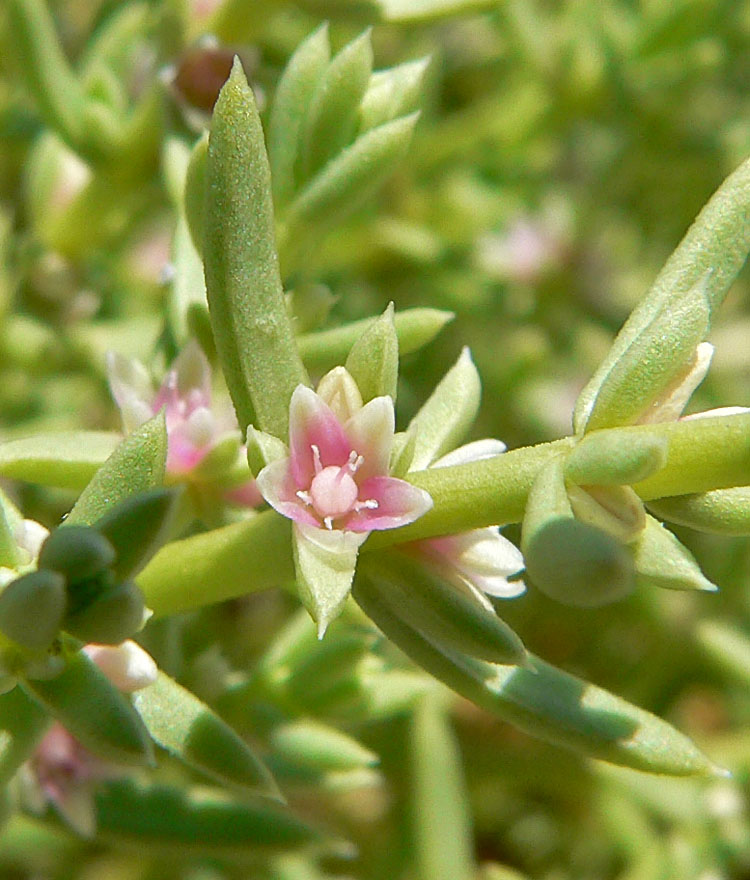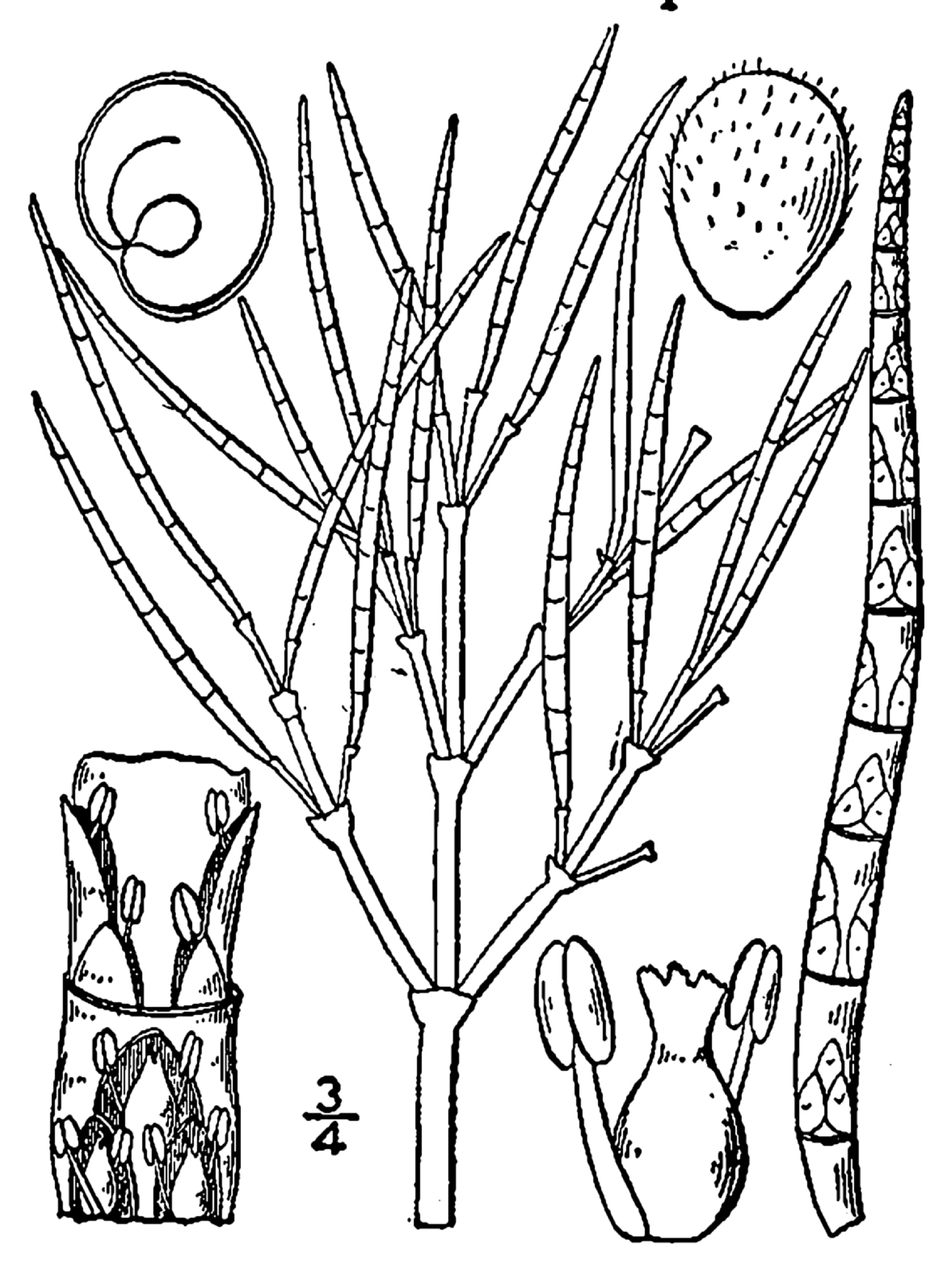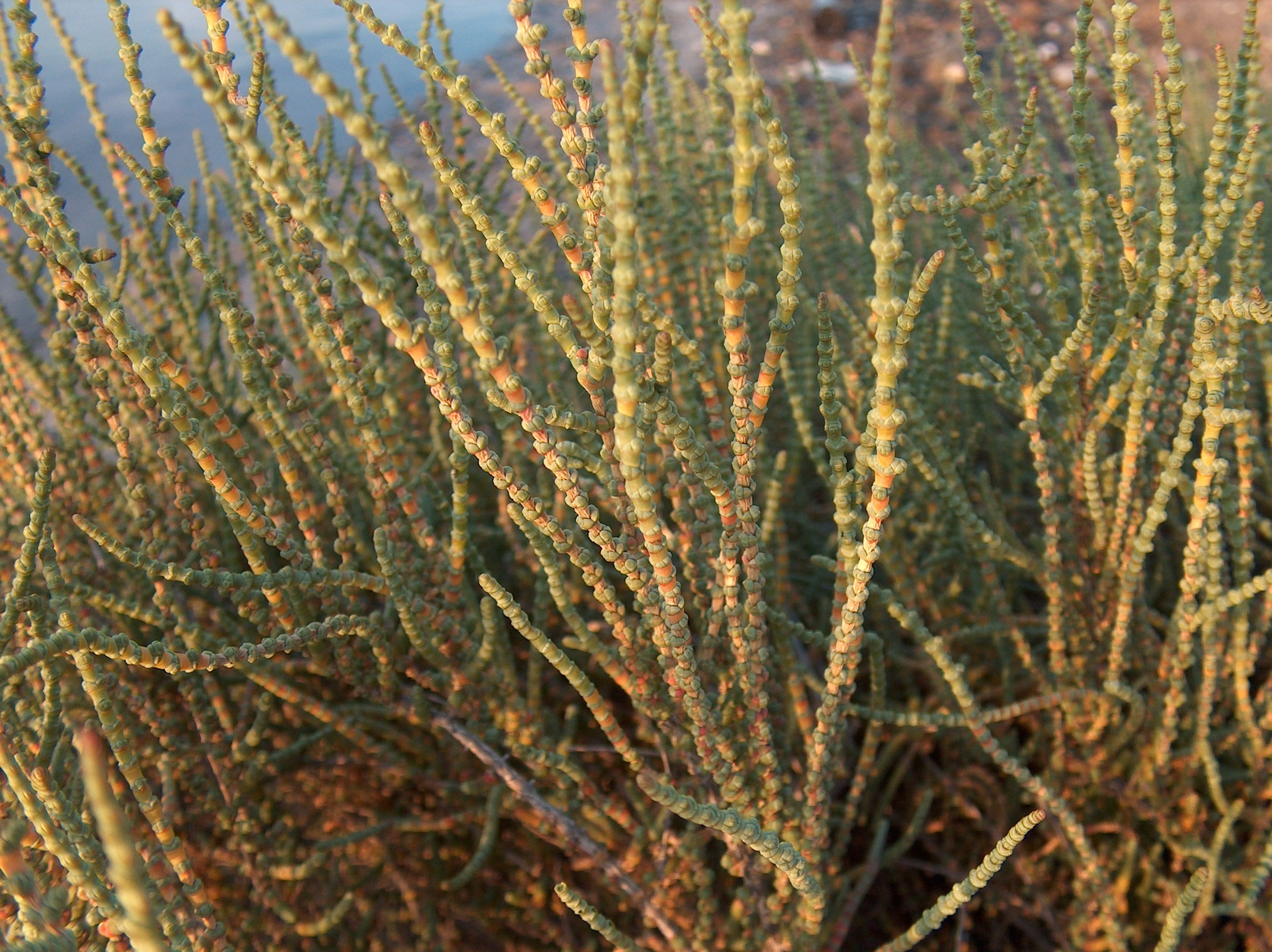|
Salicornioideae
The Salicornioideae are a subfamily of the flowering plant family Amaranthaceae (''sensu lato'', including the Chenopodiaceae). Important characters are succulent, often articulated stems, strongly reduced leaves, and flowers aggregated in thick, dense spike-shaped thyrses. These halophyte, halophytic plants are distributed worldwide. Many are edible (see Samphire) Description The Salicornioideae are Annual plant, annual or Perennial plant, perennial herbs, subshrubs, or low shrubs. Their stems are glabrous and often apparently jointed. The alternate or opposite leaf, leaves are fleshy, glabrous, often basally connate and stem-clasping (thus forming the joints), with missing or short free leaf blades. The spike-shaped inflorescences consist of alternate or opposite bracts, these are often connate and stem-clasping, sometimes free. In the axil of each bract, there are one to five (rarely to twelve) flowers, free or sometimes fused to each other, to the bract, and to the inf ... [...More Info...] [...Related Items...] OR: [Wikipedia] [Google] [Baidu] |
Amaranthaceae
Amaranthaceae is a family of flowering plants commonly known as the amaranth family, in reference to its type genus ''Amaranthus''. It includes the former goosefoot family Chenopodiaceae and contains about 165 genera and 2,040 species, making it the most species-rich lineage within its parent order, Caryophyllales. Description Vegetative characters Most species in the Amaranthaceae are annual or perennial herbs or subshrubs; others are shrubs; very few species are vines or trees. Some species are succulent. Many species have stems with thickened nodes. The wood of the perennial stem has a typical "anomalous" secondary growth; only in subfamily Polycnemoideae is secondary growth normal. The leaves are simple and mostly alternate, sometimes opposite. They never possess stipules. They are flat or terete, and their shape is extremely variable, with entire or toothed margins. In some species, the leaves are reduced to minute scales. In most cases, neither basal nor terminal aggrega ... [...More Info...] [...Related Items...] OR: [Wikipedia] [Google] [Baidu] |
Chenopodiaceae
Amaranthaceae is a family of flowering plants commonly known as the amaranth family, in reference to its type genus ''Amaranthus''. It includes the former goosefoot family Chenopodiaceae and contains about 165 genera and 2,040 species, making it the most species-rich lineage within its parent order, Caryophyllales. Description Vegetative characters Most species in the Amaranthaceae are annual or perennial herbs or subshrubs; others are shrubs; very few species are vines or trees. Some species are succulent. Many species have stems with thickened nodes. The wood of the perennial stem has a typical "anomalous" secondary growth; only in subfamily Polycnemoideae is secondary growth normal. The leaves are simple and mostly alternate, sometimes opposite. They never possess stipules. They are flat or terete, and their shape is extremely variable, with entire or toothed margins. In some species, the leaves are reduced to minute scales. In most cases, neither basal nor terminal aggrega ... [...More Info...] [...Related Items...] OR: [Wikipedia] [Google] [Baidu] |
Oskar Eberhard Ulbrich
Oskar Eberhard Ulbrich (17 September 1879 – 4 November 1952) was a German botanist and mycologist. Ulbrich was born in Berlin. He studied natural sciences at the University of Berlin, where his instructors included Adolf Engler (1844–1930) and Simon Schwendener (1829–1919). In 1926 he became a curator and professor at the Botanical Garden in Berlin, Botanical Museum in Berlin, where in 1938 he was appointed director of the ''Hauptpilzstelle''. Known for his intrafamilial investigations of the botanical families Amaranthaceae, Chenopodiaceae and Caryophyllaceae, in 1934 he subdivided Chenopodiaceae into eight subfamilies; Salicornioideae, Polycnemoideae, Chenopodioideae, Salsoloideae, et al. In 1911 he introduced usage of a color scheme to indicate geographical regions on herbarium specimens and fascicles. The plant genus ''Ulbrichia'' from the family Malvaceae was named after him by Ignatz Urban (1848–1931). Selected publications * ''Die höheren Pilze: Basidiomycetes'' ... [...More Info...] [...Related Items...] OR: [Wikipedia] [Google] [Baidu] |
Arthrocnemum Perenne
''Arthrocnemum'' was a genus of shrubs in the family Amaranthaceae. Two or three species were included in the genus. They are halophytes with fleshy, apparently articulated plant stems and reduced leaves and flowers. Description Species formerly placed in ''Arthrocnemum'' are low shrubs up to , much branched from base, and often forming mats. Young stems are succulent, glaucous (sometimes yellowish), glabrous, and appear to be articulated. The opposite leaves are sessile, joined at base and forming a cup around the stem, fleshy, glabrous, their blades reduced to small, cuspidate scales up to 5 mm. The spike-like inflorescences stand terminal on lateral branches, they are not branched or with short lateral branches. Cymes of three flowers are sitting in the axils of fleshy, opposite bracts. The flowers are bisexual (sometimes the stamens of the lateral flowers mey be missing) and proterandric. The central flower is four-angled, the two lateral flowers are three-angled. The ... [...More Info...] [...Related Items...] OR: [Wikipedia] [Google] [Baidu] |
Allenrolfea Occidentalis 4
''Allenrolfea'' is a genus of shrubs in the family Amaranthaceae. The genus was named for the English botanist Robert Allen Rolfe. There are three species, ranging from North America to South America. Description The species of ''Allenrolfea'' are subshrubs or shrubs with erect or decumbent growth. The stems are much branched, succulent, glabrous and appear to be articulated. The alternate leaves are sessile and stem-clasping, fleshy, glabrous, their blades reduced to small, broadly triangular scales, with entire margins and acute apex. The inflorescences are terminal spikes with spirally arranged flowers. Cymes of three or five flowers are sitting in the axils of deciduous, peltate, fleshy bracts. The flowers are bisexual. The perianth consists of 4-5 joined tepals, their lobes angled and truncate distally. There are 1-2 stamens exserting the flower and an ovary with 2(-3) stigmas. The fruit in an ovoid, compressed utricle with membranous pericarp. The erect seed is brown ... [...More Info...] [...Related Items...] OR: [Wikipedia] [Google] [Baidu] |
Halostachys
''Halostachys'' is a genus of flowering plants in the plant family Amaranthaceae, containing a single species, ''Halostachys caspica''. The plants are small to medium halophytic shrubs with apparently jointed fleshy stems and scale-like leaves. They are native to Asia and southeastern Europe. Description ''Halostachys caspica'' grows as a shrub to 1–3 m height and width. The erect stems are much branched, older twigs are mostly leafless. The young twigs are blue-green, fleshy, apparently jointed (articulated), with glabrous fine papillose surface. The opposite leaves are fleshy, glabrous, connate basally and surrounding the stem (thus forming the joints), with very short scale-like triangular blades. The inflorescences consist of numerous opposite lateral cylindrical spikes, 15-30 × 2–5 mm, on jointed peduncles. Groups of three bisexual flowers are sitting in the axils of rhombic-quadrate bracts. The opposite bracts are not connate to each other. The obovoid to obpyrami ... [...More Info...] [...Related Items...] OR: [Wikipedia] [Google] [Baidu] |
Salicornia
''Salicornia'' is a genus of succulent, halophytic (salt tolerant) flowering plants in the family Amaranthaceae that grow in salt marshes, on beaches, and among mangroves. ''Salicornia'' species are native to North America, Europe, Central Asia, and southern Africa. Common names for the genus include glasswort, pickleweed, picklegrass, and marsh samphire; these common names are also used for some species not in ''Salicornia''. To French speakers in Atlantic Canada, they are known colloquially as ''titines de souris'' ('mouse tits'). The main European species is often eaten, called marsh samphire in Britain, and the main North American species is occasionally sold in grocery stores or appears on restaurant menus as sea beans, samphire greens or sea asparagus. Description The ''Salicornia'' species are small annual herbs. They grow prostrate to erect, their simple or branched stems are succulent, hairless, and appear to be jointed. The opposite leaves are strongly reduced to sma ... [...More Info...] [...Related Items...] OR: [Wikipedia] [Google] [Baidu] |
Kalidium Caspicum
''Kalidium'' is a genus of flowering plants in the plant family Amaranthaceae. The species are shrubby halophytes distributed in Southeast Europe, Southwest Asia and Central Asia to China. Description The species of ''Kalidium'' grow as subshrubs or low shrubs. The stems are much branched and glabrous. Older stems are not jointed, younger stems may appear jointed or not. The alternate leaves are fleshy, glabrous, stem-clasping and decurrent, nearly orbicular to semiterete, their free blades 0.5–12 mm long. The pedunculate inflorescences are spike-like, with alternate scale-like free bracts. In the axil of each bract, there are one to three flowers, partially fused to each other, to the bract and to the inflorescence axis, appearing sunken into fleshy axis. The flowers are bisexual. The 4-5-lobed perianth consists of four to five connate tepals. There are two stamens and an ovoid ovary with two stigmas. In fruiting phase, the perianth becomes thick and spongy and encl ... [...More Info...] [...Related Items...] OR: [Wikipedia] [Google] [Baidu] |
Halocnemum
''Halocnemum'' is a genus of halophytic shrubs in the family Amaranthaceae. The plants are fleshy and apparently articulated with characteristic globular or short-cylindrical lateral branches, and reduced leaves and flowers. There are two species, occurring from Southern Europe and North Africa to Asia. Description The species of ''Halocnemum'' are subshrubs or low shrubs up to 1.5 m, much branched from base. Young stems are succulent, glabrous, apparently articulated, with characteristic globular to short-cylindrical lateral branches. The opposite leaves are fleshy, glabrous, sessile, joined at base and surrounding the stem, their blades reduced to small scales. The inflorescences are terminal or numerous opposite lateral, short-cylindrical or orbicular spikes. Cymes of (two to) three flowers are sitting in the axils of shield-like, opposite bracts. The mostly bisexual flowers are somewhat immersed in the inflorescence axis. The perianth consists of three subequal, membranous ... [...More Info...] [...Related Items...] OR: [Wikipedia] [Google] [Baidu] |
Kalidium
''Kalidium'' is a genus of flowering plants in the plant family Amaranthaceae. The species are shrubby halophytes distributed in Southeast Europe, Southwest Asia and Central Asia to China. Description The species of ''Kalidium'' grow as subshrubs or low shrubs. The stems are much branched and glabrous. Older stems are not jointed, younger stems may appear jointed or not. The alternate leaves are fleshy, glabrous, stem-clasping and decurrent, nearly orbicular to semiterete, their free blades 0.5–12 mm long. The pedunculate inflorescences are spike-like, with alternate scale-like free bracts. In the axil of each bract, there are one to three flowers, partially fused to each other, to the bract and to the inflorescence axis, appearing sunken into fleshy axis. The flowers are bisexual. The 4-5-lobed perianth consists of four to five connate tepals. There are two stamens and an ovoid ovary with two stigmas. In fruiting phase, the perianth becomes thick and spongy and encl ... [...More Info...] [...Related Items...] OR: [Wikipedia] [Google] [Baidu] |
Salicornia Europaea
''Salicornia europaea'', known as common glasswort or just glasswort, is a halophyte, halophytic annual dicot flowering plant in the family Amaranthaceae. Glasswort is a succulent herb also known as ‘Pickle weed’ or ‘Samphire, Marsh samphire’. As a succulent, it has high water content, which accounts for its slightly translucent look and gives it the descriptive name “glasswort.” To some people, it is known as “chicken toe” because of its shape. To others, it is called “saltwort.” It grows in various zones of intertidal salt marshes, on beaches, and among Mangrove, mangroves. Description Glasswort plants are relatively small and have jointed, bright green stems. During the fall, these plants turn red or purple. Their leaves are small and scale like, and they produce fleshy fruits that contain a single seed. Like most members of the subfamily Salicornioideae, ''Salicornia'' species use the C3 carbon fixation pathway to take in carbon dioxide from the surrou ... [...More Info...] [...Related Items...] OR: [Wikipedia] [Google] [Baidu] |
Halocnemum Strobilaceum
''Halocnemum strobilaceum'' is a species of flowering plant in the subfamily Salicornioideae of the family Amaranthaceae. It is native to coastal areas of the Mediterranean Sea and the Red Sea and parts of the Middle East and central Asia, where it grows in coastal and inland salt marshes, alkali flats, and other habitats with saline soils. Description ''Halocnemum strobilaceum'' is a much-branched, semi-prostrate, sub-shrub with erect branches up to a metre or so high. The woody stems at the base are jointed and have sterile, rounded or conical shaped buds, arranged in whorls on the terminal part of each portion. The erect stems are cylindrical and succulent, with green joints that turn yellow as they age. The stubby, bluish-green, scale-like leaves clasp the stem at each node. The flowers are hermaphrodite and very small, and are arranged in whorls of three on the upper part of the branches. Distribution and habitat ''Halocnemum strobilaceum'' is found around the coasts borde ... [...More Info...] [...Related Items...] OR: [Wikipedia] [Google] [Baidu] |





